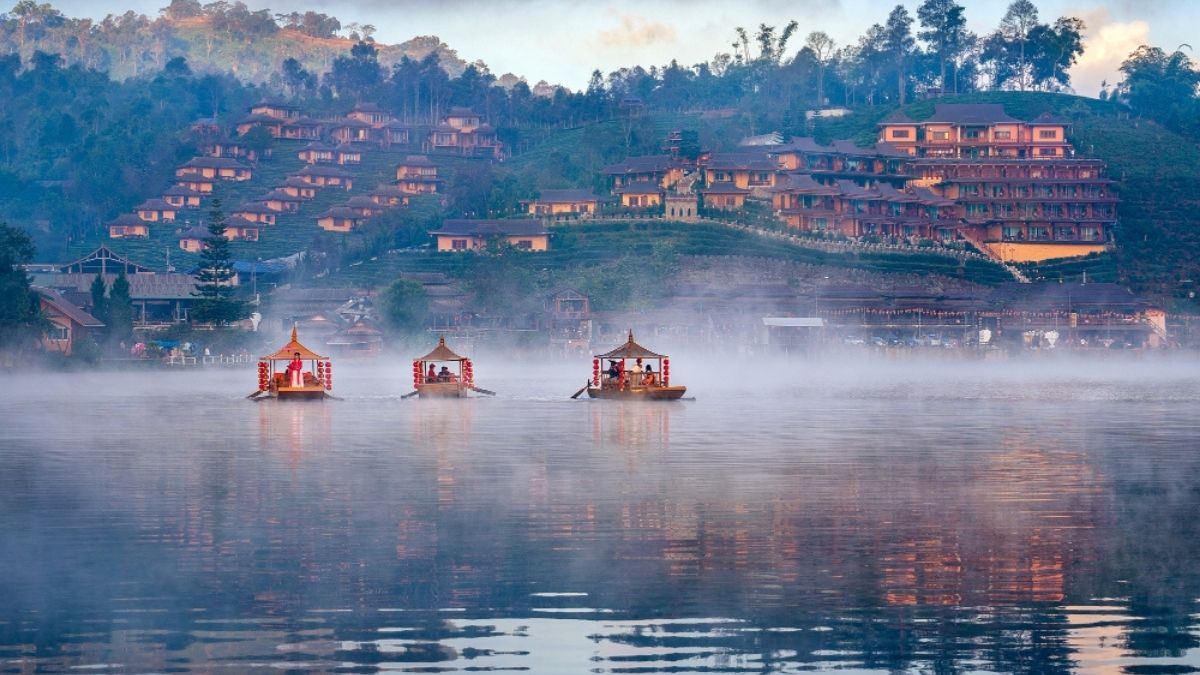Places to See in Lumbini, Nestled in the southern plains of Nepal, Lumbini stands as one of the world’s most significant pilgrimage destinations. This UNESCO World Heritage Site holds the profound distinction of being the birthplace of Siddhartha Gautama, who later became known as Buddha. For over 2,500 years, devotees, scholars, and curious travelers have journeyed to this sacred land to pay homage and seek spiritual enlightenment.
Places to See in Lumbini offers visitors a unique blend of ancient history, spiritual significance, and architectural marvels from different Buddhist traditions around the globe. The site encompasses not just the exact spot where Buddha was born, but also a carefully preserved archaeological zone, peaceful monasteries, and monuments that tell the story of Buddhism’s origins and evolution.
Whether you’re a devout Buddhist, a history enthusiast, or someone seeking a meaningful travel experience, Lumbini provides an opportunity to walk in the footsteps of one of history’s most influential spiritual leaders. The places to see in Lumbini range from ancient ruins dating back to the 3rd century BCE to modern temples built by Buddhist communities from various countries.
This comprehensive guide will take you through the essential destinations within Lumbini, helping you understand their significance and plan a respectful, enriching visit to this sacred site.
Maya Devi Temple: The Sacred Heart of Lumbini
The Maya Devi Temple stands at the very center of Lumbini’s sacred geography, marking the exact spot where Queen Maya Devi gave birth to Prince Siddhartha. This modern temple, built to protect the ancient ruins beneath, houses some of the most important archaeological discoveries in Buddhist history.
Inside the temple, visitors can observe the Marker Stone, which pinpoints the precise location of Buddha’s birth according to historical and archaeological evidence. The stone rests above excavated remains of earlier structures, including a 3rd-century BCE temple and evidence of even older wooden structures that may date back to the 6th century BCE.
The most remarkable feature within the temple is the sandstone carving depicting the birth of Buddha. This relief sculpture shows Queen Maya Devi holding onto a sal tree branch while giving birth, with other figures surrounding her in reverence. The carving, dating from the 2nd to 4th centuries CE, provides visitors with a tangible connection to the birth narrative found in Buddhist texts.
Adjacent to the temple lies the Sacred Pond, known as Puskarni, where according to tradition, Queen Maya Devi bathed before giving birth and where the newborn prince received his first ceremonial bath. The pond, surrounded by brick structures from various historical periods, continues to be an active site of worship and meditation.
Ashoka Pillar: A Testament to History, Places to See in Lumbini
Standing prominently near the Maya Devi Temple, the Ashoka Pillar serves as one of the most important historical markers in Lumbini. Erected by Emperor Ashoka in 249 BCE during his pilgrimage to Buddha’s birthplace, this sandstone pillar provides concrete historical evidence of Lumbini’s significance.
The pillar bears an inscription in the ancient Brahmi script, which translates to acknowledge Emperor Ashoka’s visit and his reverence for the site as Buddha’s birthplace. This inscription makes Lumbini one of the few places in the world where the birth location of a major religious founder can be historically verified with such ancient evidence.
The pillar, though damaged by lightning in past centuries, remains largely intact and continues to draw scholars and pilgrims alike. Its presence validates the oral traditions and texts that have long identified Lumbini as the birthplace of Buddha, bridging the gap between faith and historical documentation.
Visitors often spend time contemplating the pillar’s significance, realizing they stand in the same spot where one of history’s most influential emperors once paid his respects to Buddha’s memory. The surrounding area features additional archaeological remains from the Mauryan period, providing context for understanding ancient pilgrimage practices.
Sacred Garden: Tranquility and Reflection
The Sacred Garden encompasses the immediate area around the Maya Devi Temple and Ashoka Pillar, creating a zone of tranquility reserved for meditation and quiet contemplation. This carefully maintained space spans several acres and includes various archaeological sites, ancient ruins, and peaceful pathways.
Throughout the Sacred Garden, visitors encounter remnants of ancient monasteries, stupas, and votive structures dating from the 3rd century BCE to the 9th century CE. These ruins tell the story of Lumbini’s continuous importance as a pilgrimage destination throughout different historical periods, even during times when Buddhism declined in other parts of the Indian subcontinent.
The garden features several meditation spots where visitors can sit quietly among ancient ruins and reflect on Buddha’s teachings. The peaceful atmosphere, enhanced by the careful preservation of the natural environment, provides an ideal setting for contemplation and spiritual practice.
Walking paths wind through the Sacred Garden, connecting various archaeological sites while maintaining the serene ambiance essential for spiritual reflection. The garden’s design respects both the historical significance of the ruins and the ongoing spiritual needs of pilgrims who continue to visit this sacred space.
Places to See in Lumbini, Lumbini Museum: Archaeological Wonders
The Lumbini Museum houses an extensive collection of artifacts discovered during archaeological excavations in and around the Sacred Garden. These treasures provide visitors with deeper insights into the historical development of Lumbini as a pilgrimage site and the evolution of Buddhist art and architecture in the region.
The museum’s collection includes ancient coins, pottery, sculptures, and architectural fragments spanning over two millennia. Particularly noteworthy are the terra-cotta artifacts and votive offerings discovered in the foundations of ancient structures, which demonstrate the continuous veneration of Buddha’s birthplace throughout history.
Stone sculptures from various periods showcase the evolution of Buddhist iconography, from early symbolic representations to later anthropomorphic depictions of Buddha. These artifacts help visitors understand how Buddhist artistic traditions developed and spread from this central location to other parts of Asia.
The museum also features informative displays about the archaeological methodology used to uncover Lumbini’s ancient history. Detailed maps, photographs, and reconstructions help visitors visualize how the site appeared during different historical periods and understand the significance of ongoing research efforts.
World Peace Pagoda: Symbol of Harmony
Built by Japanese Buddhists from the Nipponzan Myohoji organization, the World Peace Pagoda stands as a modern monument to Buddha’s message of peace and non-violence. This gleaming white stupa, completed in 2001, offers visitors panoramic views of the Lumbini landscape and serves as a focal point for meditation and prayer.
The pagoda’s design follows traditional Buddhist architectural principles while incorporating modern construction techniques. Its elevated position allows visitors to appreciate the full scope of the Lumbini site, including the Sacred Garden, various monasteries, and the surrounding agricultural landscape that has remained largely unchanged for centuries.
Four golden statues of Buddha positioned around the pagoda represent different aspects of his life and teachings. These statues, facing the four cardinal directions, symbolize the universal nature of Buddhist compassion and the spread of dharma throughout the world.
The peaceful environment around the World Peace Pagoda attracts visitors seeking quiet contemplation and those interested in understanding how contemporary Buddhist communities honor Buddha’s legacy. The site often hosts meditation sessions and peaceful gatherings that emphasize Buddhism’s core principles of harmony and understanding.
Monasteries from Around the World
Lumbini’s monastic zone features temples and monasteries built by Buddhist communities from various countries, creating a unique international spiritual campus. These diverse architectural representations demonstrate how Buddhism has adapted to different cultures while maintaining its essential teachings.
The Myanmar Golden Temple showcases traditional Burmese Buddhist architecture with its distinctive golden spires and intricate woodwork. Inside, visitors can observe beautiful murals depicting scenes from Buddha’s life and traditional Myanmar Buddhist artistic styles.
The Thai Temple, with its characteristic red roof and ornate decorations, provides an example of Theravada Buddhist temple architecture. The temple’s design incorporates elements traditional to Thai Buddhist worship, including detailed Buddha statues and colorful ceremonial decorations.
The Cambodian Temple represents Khmer Buddhist traditions, featuring architectural elements reminiscent of Angkor-era temples. Its design bridges ancient Khmer artistic traditions with contemporary Buddhist worship practices.
Other notable monasteries include temples built by Buddhist communities from Sri Lanka, China, South Korea, Vietnam, and Germany. Each structure offers visitors insights into how different cultures interpret and express Buddhist architectural and artistic traditions while honoring their shared spiritual heritage.
Crane Sanctuary: Nature and Spirituality
Adjacent to the main pilgrimage areas, the Lumbini Crane Sanctuary provides habitat for various bird species, including the endangered Sarus Crane. This protected area demonstrates the Buddhist principle of compassion toward all living beings while offering visitors opportunities to observe wildlife in their natural environment.
The sanctuary encompasses wetlands and grasslands that support diverse ecosystems. During winter months, the area becomes particularly active with migratory birds, creating excellent opportunities for nature observation and photography.
Walking trails through the sanctuary allow visitors to combine spiritual reflection with nature appreciation. The peaceful environment, enhanced by bird songs and natural landscapes, provides an alternative space for meditation and contemplation away from the more formal religious sites.
The sanctuary’s existence reflects Lumbini’s commitment to environmental conservation and demonstrates how spiritual values can be integrated with wildlife protection efforts. Educational programs help visitors understand the connection between Buddhist teachings about compassion and contemporary conservation practices.
Practical Information: Planning Your Visit
Lumbini is located in the Rupandehi District of Nepal, approximately 25 kilometers from the Indian border. The nearest major city is Bhairahawa, which has an airport with regular flights to and from Kathmandu. From Bhairahawa, Lumbini is about 30 minutes away by taxi or bus.
Accommodation options in Lumbini range from budget guesthouses to comfortable hotels. Many monasteries also offer simple lodging for pilgrims, providing an opportunity to experience monastic hospitality. The Lumbini Hotel Kasai and Hotel Peace Palace are among the more established accommodation options.
The site is open year-round, but the best visiting conditions occur during the cooler months from October to March. Summer months can be quite hot and humid, while monsoon season (June to September) brings heavy rains that may affect outdoor activities.
Entry to the Sacred Garden requires a small fee for foreign visitors, while most individual monasteries and temples are free to enter. Visitors should plan to spend at least a full day exploring the main sites, though those seeking a deeper spiritual experience often stay for several days.
Travel Tips: Respectful and Meaningful Visit
When visiting places to see in Lumbini, respectful behavior is essential given the site’s sacred nature. Dress modestly, covering shoulders and knees, and remove shoes when entering temple buildings. Photography is generally permitted in outdoor areas but may be restricted inside certain temples.
Maintain quiet, respectful behavior throughout the Sacred Garden area. Many visitors come to Lumbini for meditation and spiritual practice, so loud conversations or disruptive behavior should be avoided.
Consider hiring a local guide who can provide detailed explanations of the archaeological sites and their historical significance. Knowledgeable guides enhance the visit by explaining the cultural and religious context that might not be immediately apparent to first-time visitors.
Bring water and sun protection, as the site involves considerable walking in open areas. Comfortable walking shoes are essential for exploring the various temples and archaeological sites spread throughout the complex.
Embracing Lumbini’s Timeless Legacy
Lumbini offers visitors far more than a typical tourist destination. The places to see in Lumbini provide a profound journey through history, spirituality, and human achievement that continues to inspire people from all backgrounds and beliefs.
Standing in the exact location where Buddha was born creates a powerful connection to one of humanity’s most influential spiritual teachers. The archaeological evidence, combined with ongoing religious practice, demonstrates how spiritual significance can endure across millennia while adapting to contemporary needs.
The international monasteries surrounding the Sacred Garden illustrate Buddhism’s global reach and its ability to transcend cultural boundaries while maintaining core principles of compassion, wisdom, and peaceful coexistence. These diverse expressions of faith create a unique environment where visitors can observe unity within diversity.
Whether you come to Lumbini as a pilgrim, scholar, or curious traveler, the experience offers opportunities for reflection on fundamental questions about human existence, suffering, and the search for meaning. The peaceful environment and rich history provide a perfect setting for contemplating these timeless concerns while walking in the footsteps of countless others who have made this same spiritual journey throughout the centuries.
Conclusion
Places to See in Lumbini stands as a timeless symbol of peace, spirituality, and human connection. Its serene atmosphere and profound historical significance make it a destination not only for religious devotion but also for personal reflection and cultural appreciation. The lessons and experiences found in this sacred place transcend boundaries, reminding us of the shared values that unite humanity. Visiting Lumbini is not merely a physical journey but a spiritual one, offering a sense of inner peace and a deeper understanding of life’s greater purpose.






